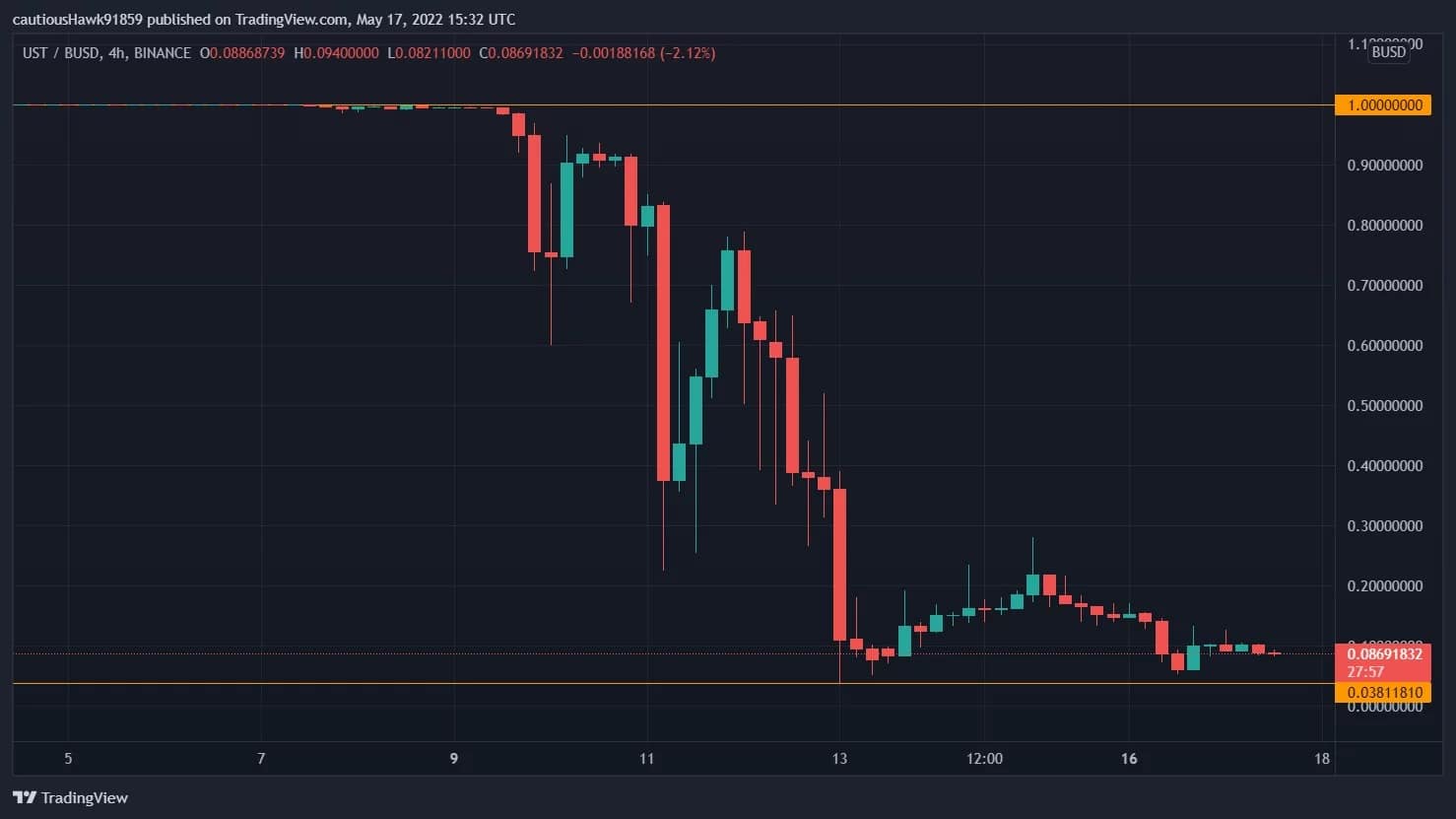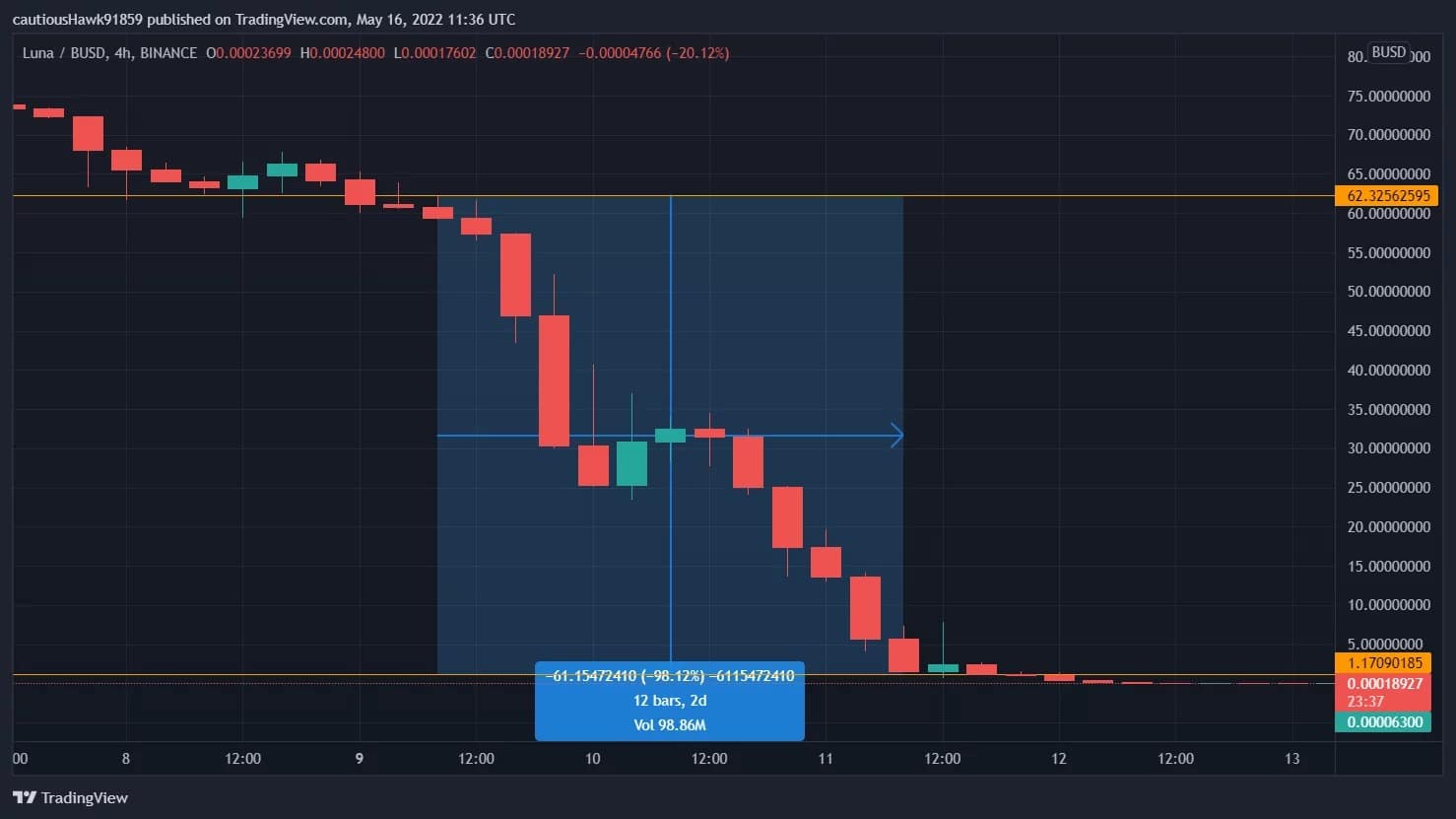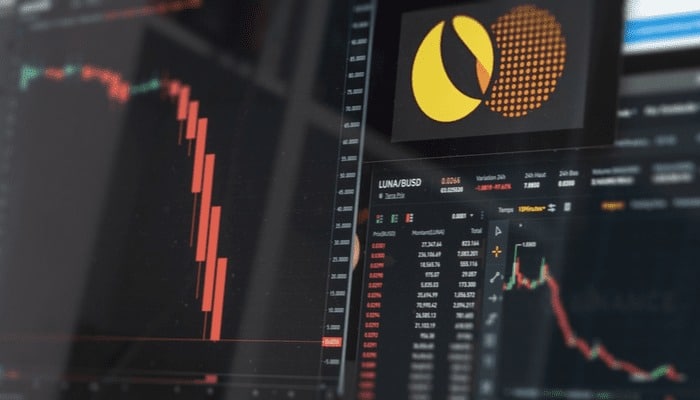The Terra ecosystem, which offered the 3rd most capitalised stablecoin (UST) at $18 billion as well as the token LUNA, collapsed in the space of a few days before the eyes of investors. It was one of the most brutal crashes in the history of cryptocurrencies, with ramifications far beyond Terra. We take a look at the short and long-term consequences, the companies impacted, and what this may portend for the industry as a whole.
Fact check: why did the Terra project collapse?
The setbacks of Project Terra, its cryptocurrency LUNA and its stablecoin UST, began over the weekend of May 7.
As all cryptocurrencies began a nosedive, the price of UST began to slip below $1.
As a reminder, the UST stablecoin was supposed to maintain parity with the US dollar through an algorithmic mechanism, unlike other centralised stablecoins, which are backed by dollar reserves or linked assets.
An arbitrage mechanism is supposed to come into play to maintain the UST’s price. If the price falls, users can exchange one UST for the equivalent of one dollar in LUNA to increase its value. The mechanism is reversed if the UST price rises above one dollar.
But the current price volatility, and panic among market participants, has played its part. When cryptocurrency prices started to fall, a large number of investors burned USTs to recover LUNA, in order to sell it as soon as possible.
Faced with this massive wave of selling, the UST arbitrage mechanism could not react fast enough, and the stablecoin lost its value, first gradually and then sharply:

Figure 1: UST’s catastrophic fall from 9 May
This created a vicious circle, where the LUNA price also fell sharply, losing 99% of its value in just two days. The token fell so far that it ended up trading below the UST price.
On the morning of 12 May, it was worth only $0.01. A week earlier, it was still trading above 80 dollars. In effect, nearly $30 billion in capitalization went up in smoke.

Figure 2: LUNA stalls and explodes in midair
For Terra, this is a catastrophe: the project, which had attracted many investors, has lost the confidence of the vast majority of the ecosystem in the space of a few days. But the ramifications of this major incident go much further than that, as we shall see.
Decentralised finance projects at risk
The first piece of good news is that the behemoths of the decentralised finance universe (DeFi) that could have seen some of the collateral evaporate, such as the Aave or Compound protocols, did not suffer any losses.
Indeed, by its nature, the risk assessment teams of these projects had not authorised the collateralisation of Terra’s UST. In short, the UST could not be used to borrow another token, creating a debt problem.
“The UST was not at the level necessary to be a collateral on Aave,” confirms Alex Bertomeu-Gilles, head of risk at Aave, the first decentralised finance protocol. However, there was a governance risk:
Given the size and resources that the Terra system had achieved, it was in a position to corrupt governance systems by buying governance tokens. A situation that can quickly get out of hand, but fortunately contained in this case.
The risk of a governance attack is often underestimated by communities. For a very small amount of money, entities could have bought massive amounts of LUNA tokens to vote for proposals that would be detrimental to the industry.
This is the nature of DAOs, decentralised autonomous organisations, where token holders are responsible for the associated protocols. It is also to prevent this that the Terra blockchain was halted twice last week.
Liquidity pools impacted
Some liquidity pools were unbalanced, however, amplifying some users’ UST token exposure, and thus their losses. But again, this did not jeopardise the solvency or operation of the majority protocols, such as Curve.
Some compare the escalation of risks to a Lehman Brothers scenario (the investment bank that failed and initiated the 2008 crisis), but the probability is low.
Why? For one thing, other stablecoins, including the USDC or USDT, have a very different stabilisation mechanism than the UST. The USDC and the USDT, issued by Circle and Tether respectively, are backed by dollars or equivalent in the issuing companies’ own accounts.
Where for UST, the stabilisation mechanism was quite different. A cascading liquidation like the one experienced by the UST and a fall to $0 of these stablecoins can therefore be excluded.
Other stablecoins, however, make partial use of UST as collateral. This is the case for the MIM, which uses it for 2% of its reserves, according to the latest protocol report.
This is still a digestible percentage for this USD 2 billion capitalization project, which in March was 40% collateralized by UST. A change in the team’s strategy probably saved the project.
For Alex Bertomeu-Gilles, last week ultimately showed that cryptocurrencies can withstand a major crisis:
However, this week has proven the resilience of our ecosystem, which has withstood the waves of shocks day in and day out, among others thanks to other stablecoins, notably USDT, backed by dollars in the bank, whose peg has come under pressure, but which has withstood thanks to the process of redemption of dollars in exchange.
As a reminder, the USDT briefly fell to $0.95 late last week as panic gripped the markets. But the drop was brief, again highlighting the difference between stablecoins of this type and those based on an algorithm.
